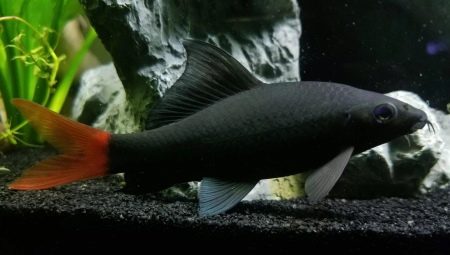Labeo Bicolor is a bright aquarium fish that can grow up to 20 cm in length. This resident of exotic Thailand is almost never found in nature, but he is actively bred in captivity. Simple care makes two-color labeos a suitable pet for both beginners and experienced aquarists. But getting offspring from this fish is not so easy, therefore the value of the species is still high, and lovers consider its acquisition a great success.
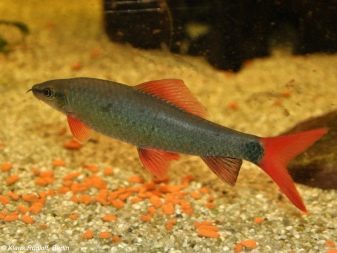
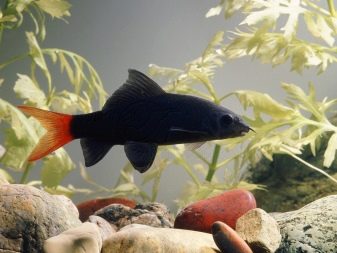
Description
Labeo bicolor is able to become a true decoration of a large aquarium. In addition to a bright appearance, this representative of the cyprinid family also has a high level of physical activity. Sometimes two-tone labeos are even called "Thai fighters" - the inhabitants of the aquarium demonstrate such a cocky character. However, watching such a pet is much more interesting than his calmer cousins.
Labeos are able to live in captivity for about 5 years, and there are long-livers who reach a ten-year age mark - it all depends on how comfortable the living conditions will be created by the owner.
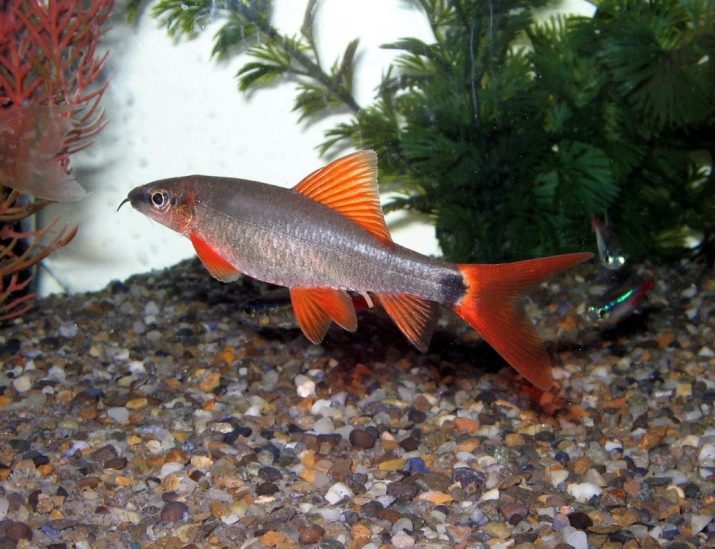
Labeo bicolor was first discovered in the 30s of the XX century in the fresh waters of the main river of Thailand - Chauphray. Wild specimens grew to 30 cm and were famous for their ability to save other inhabitants of the underwater world from parasites. Labeo bicolor was taken out of the country already in the 50s, then aquarists produced mainly controlled breeding in captivity.
The population of the species in the wild, due to various circumstances, ceased to exist in 1966.But recognized as extinct, the two-color labeo suddenly made itself felt again in the 21st century. Now assigned to him official status of endangered fish.
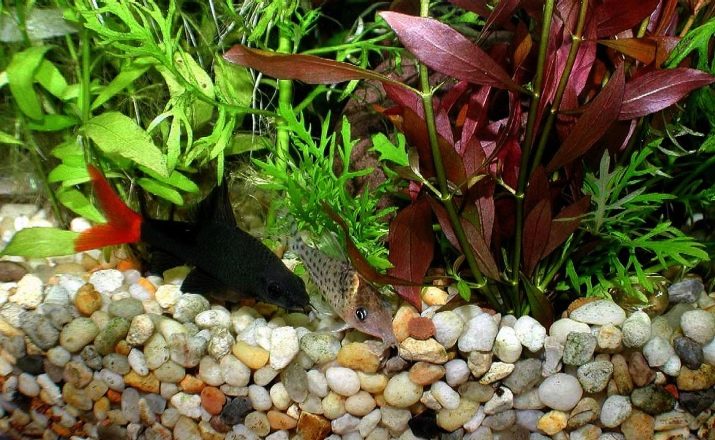
The population contained in aquariums is completely independent of these changes, since it has been bred autonomously for a long time, without a rush of blood from wild relatives.
Elegant labeo bicolor, reminiscent of the shape of the body of sharks, feel great in artificially created conditions for them. Among the features of the appearance of the two-color subspecies, the following can be noted:
- black and gray deep body color;
- contrasting tail color - scarlet;
- the body is slender, narrow, flattened laterally;
- back with a pronounced bend;
- compact head, complemented by large red eyes;
- the lower jaw in the form of a suction cup scraper;
- 2 pairs of antennae, villi on the face;
- sizes up to 12–18 cm (average); females are larger than males.
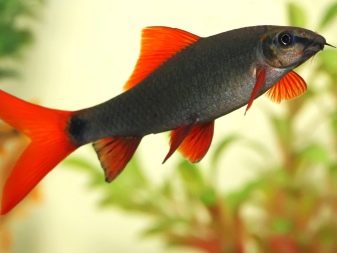

Like other representatives of the cyprinid family, Labeo Bicolor copes with the role of an aquarium orderly, absorbs excessively growing algae, and in general helps maintain normal microflora in the aquatic environment. But belonging to the genus of epalciorhinchoses (the full name of the species is Epalzeorhynchos bicolor) makes them rather aggressive in territorial disputes.

Content Rules
Features of the maintenance of two-color Labe fish are mainly associated with its need for the formation of a proper, comfortable environment. In nature, it lives exclusively in clean flowing water bodies, with abundant vegetation and a sandy bottom. During periods of floods, the Labeo Bicolor migrate, appearing in the most unexpected places, including peatlands, where it is quite difficult for them to survive.
When choosing fish for home content will have to make sure that she receives all the necessary conditions for a comfortable life.
It is worth considering in more detail what is needed to maintain two-color labeos. The first and most important thing is a spacious aquarium with high sides. For one fish, it is recommended to take a volume of 100 liters of water.
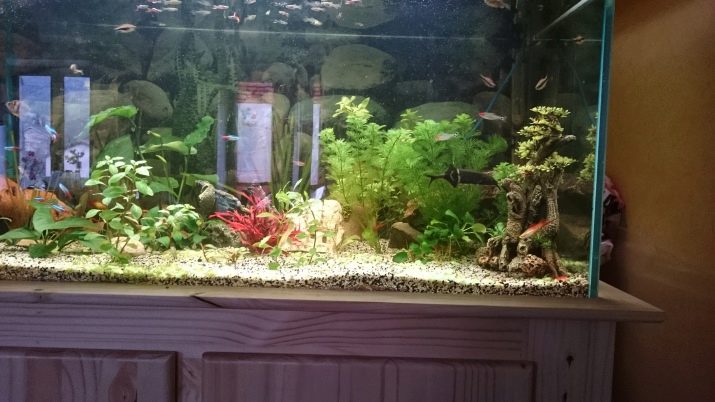
A couple will need already 200 liters, given the developed territorial instincts. The more densely populated the reservoir, the more aggressive the behavior of the labo will become. You can avoid problems by providing the capricious pet with the freedom he needs.
Requirements for water quality are also not an idle question. When the living conditions worsen, the labeos lose weight, the brightness of the color decreases, and the mobility of the fish decreases. Owner needs it is imperative to maintain optimal purity of water in the aquarium, pay attention to its transparency. It is better to take care in advance of acquiring filters and aerators that can provide sufficient saturation of the medium with oxygen, create a flow intensity similar to that of natural in small rivers.
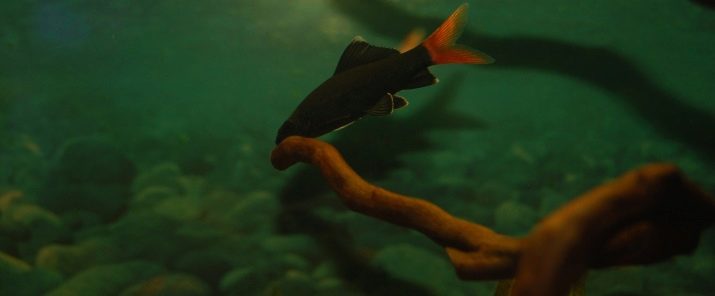
Water is replaced in the aquarium once a week, in volumes of about 25%. This allows you to maintain a level of microflora that is comfortable for its inhabitants, and avoid excessive acidification or environmental pollution.
The following are considered optimal environmental parameters:
- pH 6.5–7.5;
- temperature in the range from +23 to +27 degrees Celsius;
- stiffness - no more than 20.
For the formation of good living conditions for Labeau Bicolor, the correct selection of substrate at the bottom is required. It is good if it is pure fine sand, small pebbles. Dark soil is preferable to light.
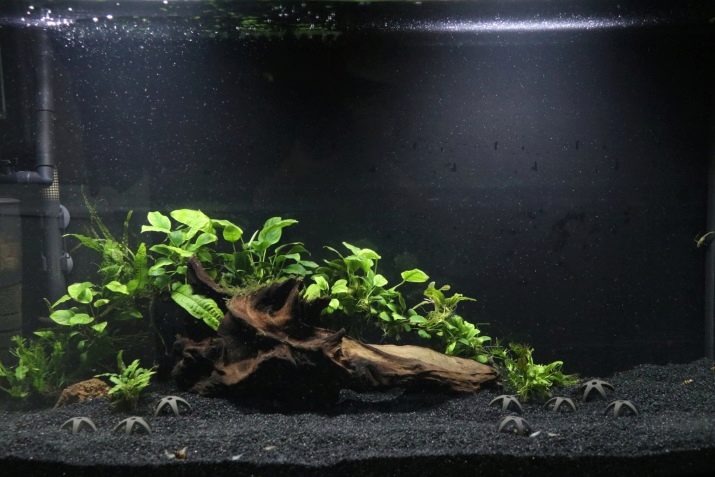
As for plants, in nature, fish of this species feed on soft algae. In the aquarium, it is also worth creating dense thickets that act as natural shelters.
The abundance of algae helps Labeau bicolor to feel more comfortable. When selecting plants, preference it is better to give varieties with a strong root system, zoning places for outdoor swimming and relaxation. Then the labeo will not show aggression against other fish. Artificial lighting in the aquarium is necessary, but it should not be too bright. A soft, diffused light is suitable, which also makes it possible to demonstrate the stats of pets favorably and emphasize the unusualness of their color.
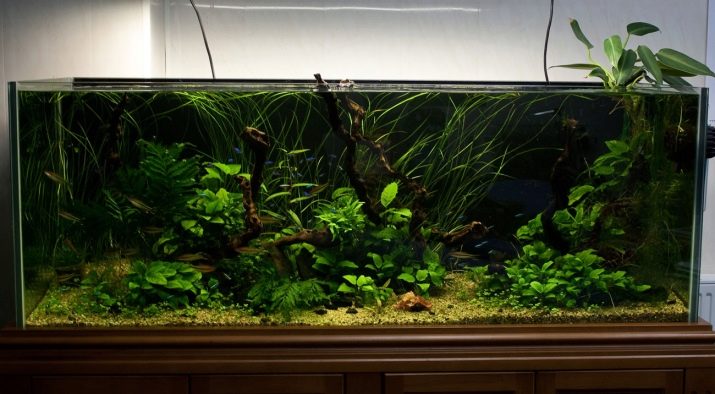
Disease prevention
Care for any aquarium fish is always associated with the peculiarities of its immunity. Labeo bicolor is not susceptible to disease, but they can also develop fungal infections, obesity, dropsy. As preventive measures, the simplest methods are most often used - changing the nutrition system, conducting antimycotic therapy. It is not excluded and parasitic infection.
Basically, aquarium inhabitants are affected by endoparasitic or gill species of worms. The correct and regular change of water in the tank helps keep pets healthy.

The cleaner the environment, the lower the chance of getting a disease or parasitic infection. For the first time after buying a labeo, you need to put it in a quarantine aquarium, avoiding contact with other individuals.
What does it eat?
Organizing the right diet for Labeau Bicolor is a serious and large-scale task for an aquarist. I wonder what this representative of the exotic world of South Asian freshwater fish eats. Generally Labeau is quite unpretentious, ready to be content with a completely plant diet and small portions of plankton. But in an artificially created environment, it is better for him to give additives of animal origin.
When selecting feed, you should pay attention to ready-made cereals, granules or tablets rich in plant fiber.
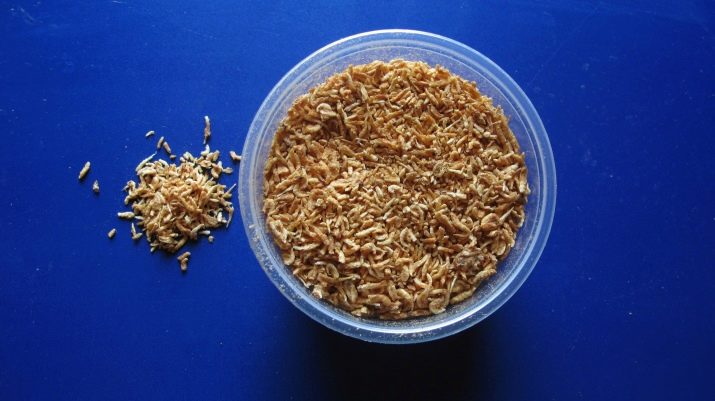
You can offer your pet a tablet version of the food, designed for Antsistrus. In addition, you can give your pet a live bloodworm, tubule, daphnia. They will also be eaten by fish with great pleasure. The frequency of feed during the day should not exceed 2 times, otherwise there is a high risk of overfeeding the pets.
Do not forget that Labeau Bicolor - a cleaner who needs to satisfy his needs.
Often experienced aquarists specifically grow a colony of algae on a plexiglass sheet, and then place it in an aquarium. For labeos, such an additive is the best delicacy.
Sometimes they are not averse to feasting and aquarium plants, but usually arrange such diversions, only very hungry. Experienced breeders advise periodically to please bicolors with such additives as oatmeal, fish paste, egg yolk, white bread. But often offering a treat is not worth it. Of vegetable crops, the most readily absorbed fish zucchini, cucumber, green peas, salad.
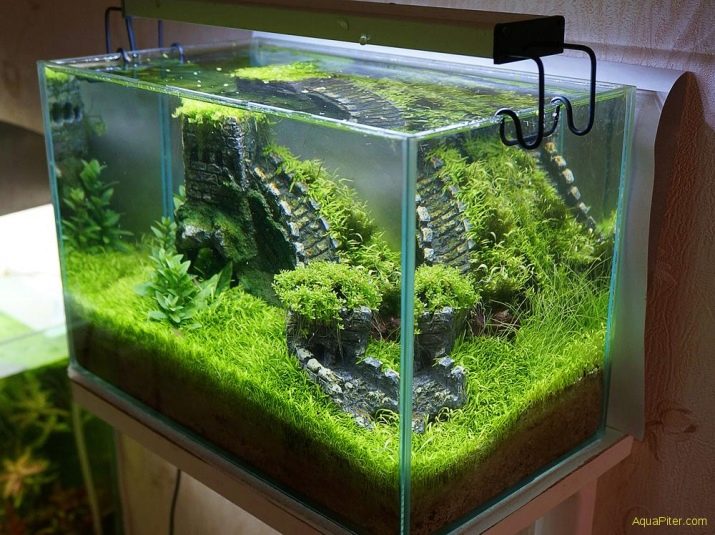
Breeding
Breeding labeo bicolor at home is a rather complicated process for an amateur aquarist. Fish spawning only begins in very spacious aquariums - from 500 l and more, after hormonal injections.
It is difficult even for experienced breeders to cope with the task independently and not harm the pet. That is why Most of the Labeo Bicolor goes to other countries from farms located in Southeast Asia.
Representatives of this bicolor species are distinguished by a rather late onset of puberty. As a rule, they are ready for breeding no earlier than 18 months of life.
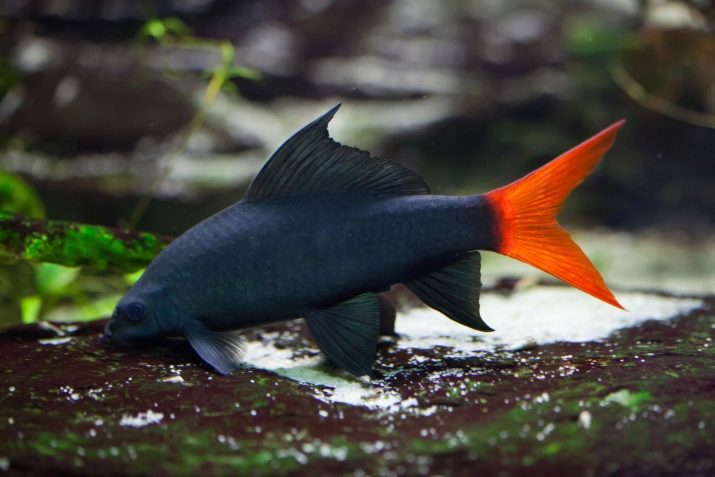
1 female and 3 males are transferred to the spawning aquarium previously sustained separately, and received in the back injection of hormones. Delayed at a time about 1000 eggs, gradually settling to the bottom.
After spawning is complete, the parents are removed from a separate aquarium with caviar. Eggs are checked, dead embryos are removed. The masonry is transferred to an incubator with warm water, about +27 degrees, a weak course. Two days after sweeping, the fry are born. They can be given ciliates, live dust. Fry labeo bicolor has a low survival rate - in the first 2 weeks, 50% of the offspring die.
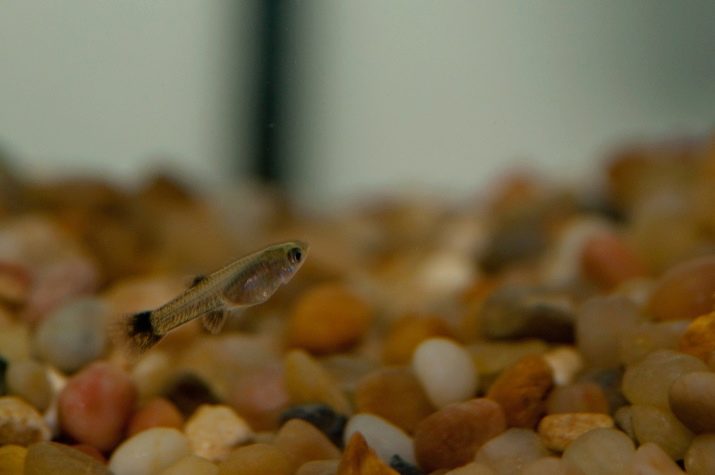
Compatible with other fish
A pugnacious character, a developed sense of territory makes the labeo bicolor not very adapted to living in multi-species aquariums.Their compatibility with other fish is quite low, you must necessarily select neighbors of a similar size or much more dynamic and mobile.
Among the options for acceptable cohabitation can be identified cohabitation with barbs - Sumatran, fiery, mossy, Malabar zebrafish, Congo, thornsia. A large aquarium with zoned areas allows you to expand the list of possible neighbors labeo bicolor. In this case, the fish may well settle together with scalars, bots, gourami.
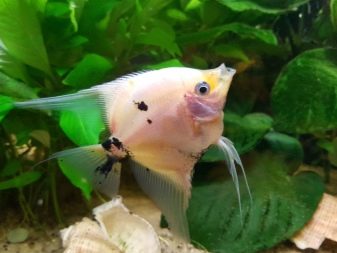
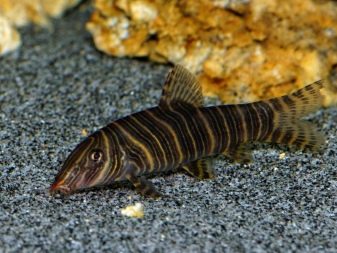
The main thing is that other representatives of the water world should not be bottom dwellers - labeos will not tolerate competition here.
Under a strict ban on co-settlement, any fish with a similar color. It can be two-color swordsmen, barbs. Intolerant representatives of the family of cyprinids and neighbors with a similar body shape. They perceive them as a potential threat. The joint maintenance of individuals of the same species is also impractical - constant fights will greatly spoil the impression of the beauty of pets.
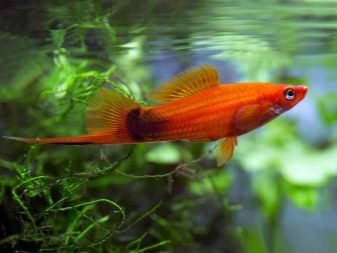
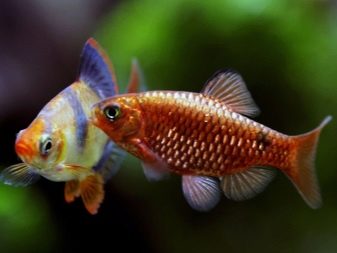
It is worth noting that in addition to the mating season, when couples are formed without fail, all two-tone labeos remain pronounced singles.
They do not feel a constant need for the company, they show aggression against each other and externally similar fish. Especially undesirable to settle in the same aquarium with these Thai fighters for speckled catfish, Antsistrus, some types of cichlids. In the struggle for territory, they lose in strength and dexterity, may die or be injured.
It is important to consider that developed territorial instincts are endowed mainly with adults. In young animals, it is much less pronounced, if the fish settles in an already inhabited aquarium, problems can often be avoided. It all depends on the individual characteristics of a particular individual and the selection of neighbors for her.
On the contents of Labeo Bicolor see below.
